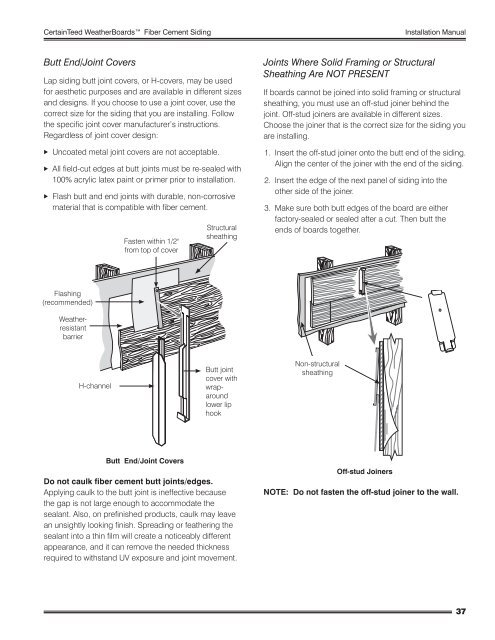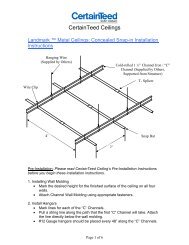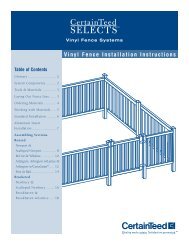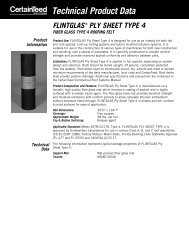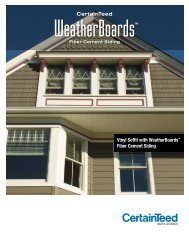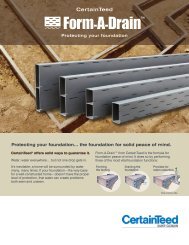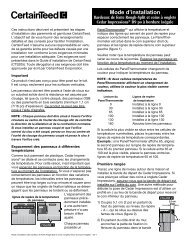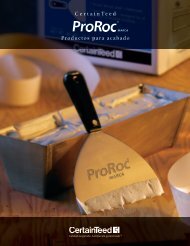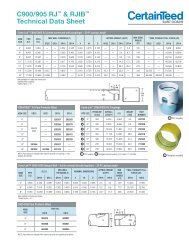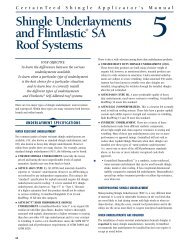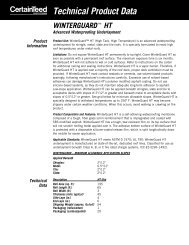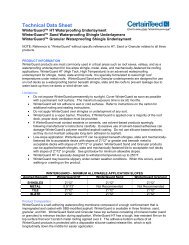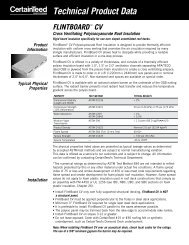Installation Manual - CertainTeed
Installation Manual - CertainTeed
Installation Manual - CertainTeed
You also want an ePaper? Increase the reach of your titles
YUMPU automatically turns print PDFs into web optimized ePapers that Google loves.
<strong>CertainTeed</strong> WeatherBoards Fiber Cement Siding <strong>Installation</strong> <strong>Manual</strong><br />
Butt End/Joint Covers<br />
Lap siding butt joint covers, or H-covers, may be used<br />
for aesthetic purposes and are available in different sizes<br />
and designs. If you choose to use a joint cover, use the<br />
correct size for the siding that you are installing. Follow<br />
the specific joint cover manufacturer’s instructions.<br />
Regardless of joint cover design:<br />
XXUncoated metal joint covers are not acceptable.<br />
XXAll field-cut edges at butt joints must be re-sealed with<br />
100% acrylic latex paint or primer prior to installation.<br />
XXFlash butt and end joints with durable, non-corrosive<br />
material that is compatible with fiber cement.<br />
Flashing<br />
(recommended)<br />
Weatherresistant<br />
barrier<br />
H-channel<br />
Fasten within 1/2"<br />
from top of cover<br />
Butt End/Joint Covers<br />
Structural<br />
sheathing<br />
Butt joint<br />
cover with<br />
wrap-<br />
around<br />
lower lip<br />
hook<br />
Do not caulk fiber cement butt joints/edges.<br />
Applying caulk to the butt joint is ineffective because<br />
the gap is not large enough to accommodate the<br />
sealant. Also, on prefinished products, caulk may leave<br />
an unsightly looking finish. Spreading or feathering the<br />
sealant into a thin film will create a noticeably different<br />
appearance, and it can remove the needed thickness<br />
required to withstand UV exposure and joint movement.<br />
Joints Where Solid Framing or Structural<br />
Sheathing Are NOT PRESENT<br />
If boards cannot be joined into solid framing or structural<br />
sheathing, you must use an off-stud joiner behind the<br />
joint. Off-stud joiners are available in different sizes.<br />
Choose the joiner that is the correct size for the siding you<br />
are installing.<br />
1. Insert the off-stud joiner onto the butt end of the siding.<br />
Align the center of the joiner with the end of the siding.<br />
2. Insert the edge of the next panel of siding into the<br />
other side of the joiner.<br />
3. Make sure both butt edges of the board are either<br />
factory-sealed or sealed after a cut. Then butt the<br />
ends of boards together.<br />
Non-structural<br />
sheathing<br />
Off-stud Joiners<br />
NOTE: Do not fasten the off-stud joiner to the wall.<br />
37


